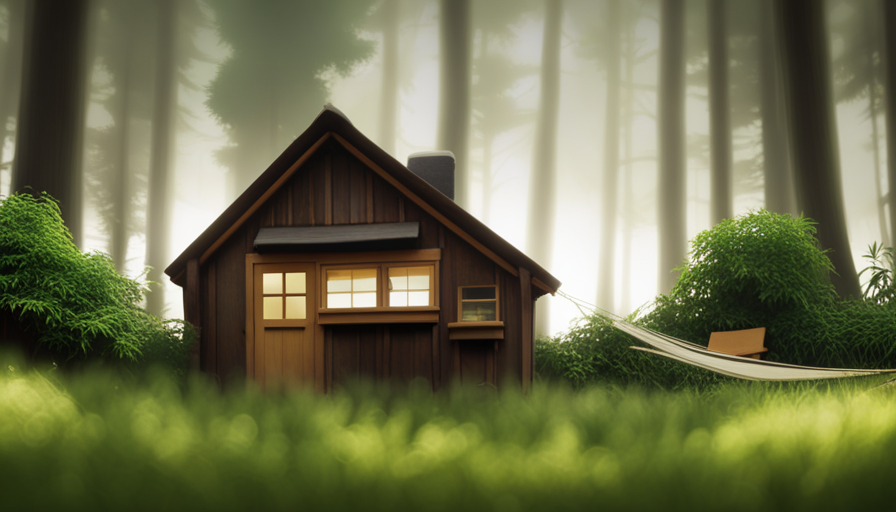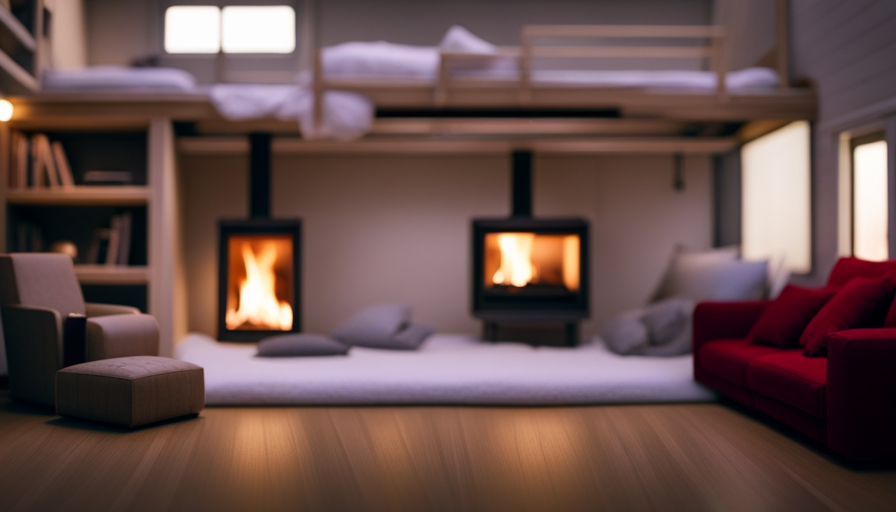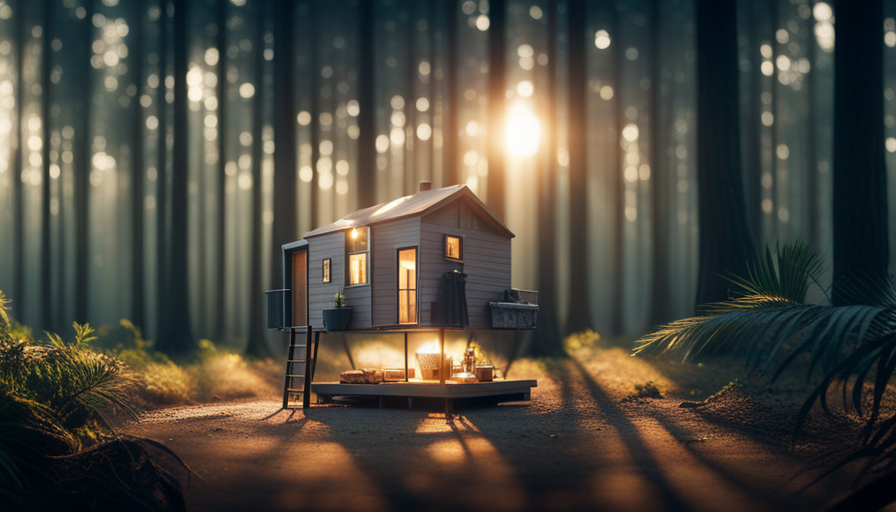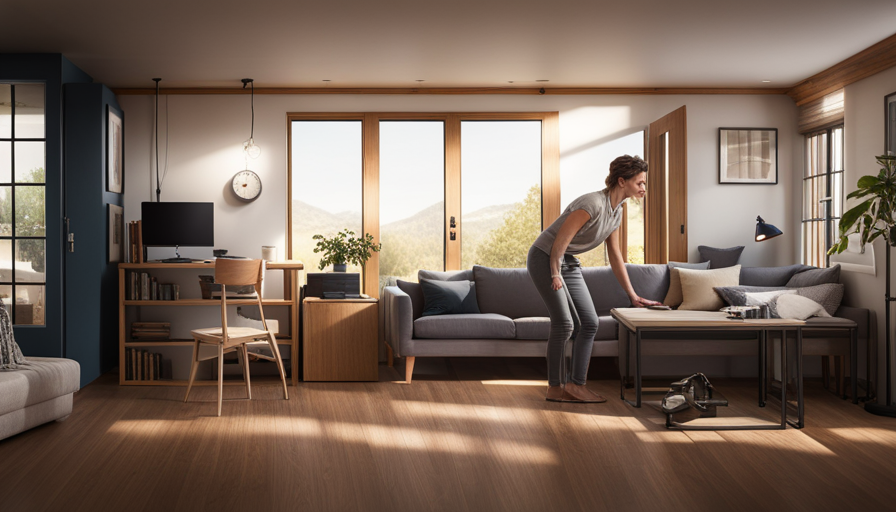Living in a tiny home is like sailing the vast seas, where space is limited but freedom is boundless. This lifestyle celebrates minimalism, simplicity, and a daring attitude. Just like sailors navigating the ocean, those who opt for tiny homes navigate life with purpose, clear goals, and a desire to live harmoniously with the environment.
But how long do people stay in their tiny houses? What factors influence their duration of stay? In this article, we will delve into the reasons why people choose a tiny house lifestyle, the financial benefits of living in a tiny house, and the challenges and benefits of long-term tiny house living. We will also explore stories from individuals who have called a tiny house their home for extended periods.
Whether you’re considering downsizing or simply curious about the tiny house movement, join me on this journey to discover the captivating world of tiny house living and the lengths to which people go to make it their own.
Key Takeaways
- People typically stay in their tiny houses for around two to five years on average.
- Factors such as location, design, and community engagement can influence the duration of stay.
- Living in a tiny house offers cost savings, a more minimalist lifestyle, and reduced utility bills.
- Lifestyle changes and the need for more space are common reasons for leaving a tiny house.
Reasons for Choosing a Tiny House Lifestyle
One of the primary reasons individuals opt for a tiny house lifestyle is the desire to simplify their lives and reduce their environmental footprint. Living in a tiny house promotes a sustainable way of living by minimizing the use of resources and energy consumption. These small homes are typically designed to be energy-efficient, with features such as solar panels, rainwater collection systems, and composting toilets.
By adopting a minimalist lifestyle, individuals can significantly reduce their carbon footprint and contribute to a more sustainable future. The sustainability benefits of living in a tiny house extend beyond environmental considerations. With limited space, individuals are forced to downsize and prioritize their belongings. This promotes conscious consumption and discourages excessive materialism. By owning fewer possessions, individuals can reduce waste and contribute to a more sustainable society.
Furthermore, the minimalist lifestyle that comes with living in a tiny house can bring a sense of freedom and contentment. By focusing on experiences rather than material possessions, individuals can lead a more fulfilling life. The simplicity of a tiny house encourages individuals to spend more time outdoors, engage in community activities, and connect with nature.
Transitioning into the subsequent section about the financial benefits of living in a tiny house, the minimalist lifestyle also offers significant financial advantages.
Financial Benefits of Living in a Tiny House
Living in a tiny house offers you the opportunity to reap financial benefits and experience the freedom of a more minimalist lifestyle. Here are three key ways in which living in a tiny house can lead to cost savings and a more minimalist lifestyle:
-
Reduced Utility Bills: With a smaller living space, you can expect lower utility bills. Heating, cooling, and electricity costs are significantly reduced in a tiny house due to the smaller square footage. This can result in substantial savings over time.
-
Minimal Maintenance Costs: Maintaining a tiny house is much more affordable compared to a traditional home. With fewer rooms, less square footage, and fewer appliances, there’s less to clean, repair, and maintain. This translates to lower maintenance costs and more money in your pocket.
-
Lower Property Taxes: Tiny houses are generally considered personal property rather than real estate, resulting in lower property taxes. This can lead to significant savings, allowing you to allocate your funds towards other priorities.
Living in a tiny house not only allows for cost savings but also promotes a more minimalist lifestyle. The reduced space encourages you to declutter and prioritize your belongings, leading to a simpler and more intentional way of living. This shift towards minimalism can bring a sense of freedom and contentment.
Transitioning to the next section, factors such as personal circumstances and lifestyle choices greatly influence the duration of stay in a tiny house.
Factors That Influence the Duration of Stay in a Tiny House
Imagine the freedom you’ll experience when you consider the factors that can impact how long you’ll be able to call your tiny house home. Factors such as location, design and layout, and community engagement play a crucial role in influencing the duration of stay in a tiny house. Let’s delve into each of these factors and understand their influence on satisfaction and mental health.
Location is a significant factor that can impact how long someone stays in a tiny house. If the tiny house is situated in a picturesque and serene environment, it can contribute to a higher satisfaction level and promote a sense of well-being. On the other hand, a noisy or crowded location may lead to dissatisfaction and negatively impact mental health.
The design and layout of the tiny house also play a vital role. A well-designed tiny house with optimized space utilization and functional amenities can enhance satisfaction and contribute to a longer stay. Conversely, a poorly designed or cramped space may lead to frustration and a shorter duration of stay.
Community engagement is another essential factor. Living in a tight-knit tiny house community can foster a sense of belonging and social connection, which positively impacts satisfaction and mental health. Conversely, a lack of community engagement may lead to a feeling of isolation and reduce the duration of stay.
Understanding these factors is crucial in determining the optimal conditions for a fulfilling experience in a tiny house. By considering location, design and layout, and community engagement, individuals can create an environment that maximizes satisfaction and promotes long-term stay. Transitioning into the subsequent section about the typical duration of stay in a tiny house, it’s important to explore the various factors that influence this aspect.
Typical Duration of Stay in a Tiny House
The duration of stay in a tiny house can vary depending on several factors such as location, design, and community engagement. On average, people tend to stay in their tiny houses for around two to five years. However, it’s important to note that this is just an average length, and there are individuals who choose to stay in their tiny houses for longer or shorter periods of time.
There are several reasons why people may choose to leave their tiny houses. One common reason is a change in lifestyle or personal circumstances. For example, someone might initially choose to downsize into a tiny house to save money, but later find themselves needing more space due to a growing family or a change in job.
Another factor that can influence the duration of stay in a tiny house is the design and functionality of the space. If someone finds that their tiny house no longer meets their needs or lacks essential amenities, they may decide to move on to a larger living arrangement.
In the next section, we’ll explore the challenges and benefits of living in a tiny house long-term. It’s important to consider these factors when deciding whether a tiny house is the right fit for you in the long run.
Challenges and Benefits of Living in a Tiny House Long-Term
Despite the cozy confines, living in a tiny house for an extended period can present both hurdles and advantages.
One of the main challenges of downsizing to a tiny house is the limited space. It requires careful organization and creative storage solutions to make the most of every inch. Additionally, the emotional impact of living in a tiny house should not be underestimated. It can be difficult to adjust to a smaller living space, especially if you’re used to more room. Feelings of claustrophobia and a sense of confinement may arise, requiring a conscious effort to adapt and find contentment in the simplicity of the lifestyle.
However, there are also numerous benefits to living in a tiny house long-term. One of the most significant advantages is the financial freedom it provides. With lower utility bills, reduced maintenance costs, and the ability to live mortgage-free, tiny house dwellers often find themselves with more disposable income. Additionally, the minimalistic nature of tiny house living promotes a sense of mindfulness and intentional living. It encourages a focus on what truly matters, leading to a simpler and more fulfilling life.
While living in a tiny house long-term can present challenges, such as the need to downsize and the emotional impact of a smaller space, it also offers numerous benefits, including financial freedom and a more intentional lifestyle. By embracing the challenges and making the most of the advantages, you can truly thrive in a tiny house. Transitioning into the subsequent section about tips for making the most of your time in a tiny house, it’s essential to find strategies that enhance both the functionality and enjoyment of your tiny living space.
Tips for Making the Most of Your Time in a Tiny House
To fully embrace and optimize your time in a tiny house, you’ll want to take advantage of these practical tips and tricks. Maximizing space is essential in a tiny house, as every square inch counts.
One effective way to do this is by utilizing vertical storage solutions. Install shelves or hooks on the walls to keep your belongings off the floor and create a more spacious atmosphere.
Another tip is to invest in multifunctional furniture. Choose pieces that can serve multiple purposes, such as a sofa that can also be used as a bed or a table with built-in storage compartments.
Additionally, organizing your belongings is crucial in a tiny house. Use bins, baskets, and drawer dividers to keep everything in its place and easily accessible. Consider implementing a capsule wardrobe to minimize the number of clothes you own, freeing up valuable closet space.
Lastly, don’t forget to make use of outdoor living areas, such as a patio or deck, to extend your living space. By following these tips, you can make the most of your time in a tiny house and create a comfortable, functional living environment.
Transitioning into the subsequent section about stories from people who’ve lived in tiny houses for extended periods, it’s inspiring to hear how others have made the most of their tiny house living experience.
Stories from People Who Have Lived in Tiny Houses for Extended Periods
Imagine walking through the door of your cozy tiny home and hearing stories from individuals who’ve lived in these small spaces for extended periods of time. It’s truly fascinating to listen to their experiences and learn about the benefits of sustainable living and minimalism.
These courageous individuals have embraced the idea of downsizing and found joy in simplifying their lives. Living in a tiny house allows them to reduce their ecological footprint and live a more environmentally friendly lifestyle. By utilizing renewable energy sources and adopting efficient habits, they’ve found creative ways to make the most of their limited space.
Through extensive research and careful planning, they’ve discovered effective storage solutions, innovative multi-purpose furniture, and ingenious design techniques that maximize the functionality of their tiny homes. They’ve also learned to prioritize experiences over material possessions, leading to a more fulfilling and meaningful life. By embracing minimalism, they’ve freed themselves from the burden of excessive belongings and cultivated a sense of contentment and gratitude for what they have.
As we delve into the next section about how to transition out of living in a tiny house, we can draw inspiration from these remarkable individuals and their stories. They’ve shown us that living in a tiny house is not just a temporary experiment, but a long-term sustainable lifestyle choice that can bring immense joy and fulfillment.
How to Transition Out of Living in a Tiny House
Transitioning out of living in a tiny house can present its own set of challenges. After spending an extended period in a compact space, it can be overwhelming to transition back to a larger living arrangement. However, with proper planning and organization, this transition can be smooth and stress-free.
When it comes to transitioning out of living in a tiny house, downsizing tips are essential. It’s important to assess your needs and prioritize your belongings. Start by decluttering and getting rid of any unnecessary items. Consider donating or selling items that you don’t need or use anymore.
Additionally, create a detailed plan for your new living space, making sure to measure the available area and optimize storage options.
As you navigate this transition, it’s crucial to address the emotional attachment that may arise. Letting go of a tiny house lifestyle can be challenging, but it’s important to embrace the next chapter with an open mind.
Exploring alternative housing options allows for new opportunities and experiences. In the following section, we’ll delve into the various alternative housing options available, highlighting their unique features and benefits.
Exploring Alternative Housing Options
Exploring alternative housing options is like opening a door to a world of unique and exciting possibilities. When it comes to finding a place to live, there are numerous choices available that can provide both affordability and a reduced environmental impact.
One option to consider is co-housing, where individuals or families live together in a community and share common spaces. This not only promotes a sense of community and social connection, but it also allows for cost-sharing, making it a more affordable alternative to traditional housing.
Another option worth exploring is modular housing. These pre-fabricated homes are built off-site and then transported to the desired location. They offer a quick and efficient construction process, which can save both time and money. Additionally, modular homes are often designed with sustainability in mind, incorporating energy-efficient features and materials.
Tiny house communities are also gaining popularity as an alternative housing option. These communities consist of several tiny houses clustered together, providing a sense of community while still maintaining individual living spaces. They offer an affordable and environmentally-friendly lifestyle, with minimalistic living and reduced energy consumption.
Exploring alternative housing options can lead to a range of choices that are both affordable and have a reduced environmental impact. By considering options such as co-housing, modular housing, and tiny house communities, individuals can find unique and exciting possibilities for their living arrangements. Transitioning out of a tiny house doesn’t have to be a step backward; it can be a step towards a more sustainable and fulfilling lifestyle.
Conclusion and Final Thoughts
After exploring alternative housing options, it’s clear that tiny houses have gained significant popularity in recent years. These small, compact dwellings offer a unique and affordable solution for those seeking to downsize or live a more sustainable lifestyle.
However, it’s important to consider the challenges faced by individuals who choose to live in tiny houses. One of the main challenges is the limited space available. While the idea of living in a small house may sound appealing, it can be difficult to adjust to the cramped living conditions. Storage space is often minimal, and it requires careful organization and decluttering to make the most of the available space. Additionally, the lack of privacy can be a concern for some individuals, as there are usually no separate rooms in a tiny house.
Despite these challenges, there are numerous benefits experienced by those who choose to live in tiny houses. Firstly, the cost savings are significant, as tiny houses are typically much cheaper to build and maintain compared to traditional homes. This allows individuals to save money and potentially achieve financial freedom. Additionally, the smaller size encourages a simpler lifestyle, with less focus on material possessions and more emphasis on experiences and relationships. Moreover, the reduced environmental impact of tiny houses aligns with the growing trend of sustainability and conscious living.
While there are challenges faced by individuals who live in tiny houses, the benefits experienced in terms of cost savings, simplicity, and environmental sustainability make them an attractive alternative housing option for many.
Frequently Asked Questions
What are some common challenges that people face when living in a tiny house long-term?
Common challenges faced when living in a tiny house long-term include space management and limited storage options. Due to the limited square footage, finding innovative ways to maximize space becomes crucial. It requires meticulous organization and decluttering to ensure everything has its place.
Additionally, the lack of space can lead to feelings of confinement and a need for creative solutions to meet daily needs. However, with proper planning and efficient use of space, these challenges can be overcome, resulting in a comfortable living experience.
Can you provide some tips for maximizing storage in a tiny house?
They say ‘a place for everything and everything in its place,’ and this adage rings true for maximizing storage in a tiny house.
Creative storage solutions are essential when living in a small space. Utilize vertical space with shelves and hooks, invest in multi-purpose furniture with hidden storage compartments, and use organizers to keep belongings tidy.
These organizing tips for small spaces will help you make the most of every inch in your tiny house.
Are there any legal restrictions or zoning issues that people should be aware of when living in a tiny house?
Legal restrictions and zoning issues can pose challenges for those living in tiny houses. It’s important to research and understand local laws and regulations before embarking on this lifestyle. Some areas may have minimum square footage requirements, restrictions on where tiny houses can be parked or built, or zoning laws that prohibit living in a tiny house altogether. Compliance with these regulations is crucial to avoid fines or eviction.
How do people typically transition out of living in a tiny house?
Transitioning out of living in a tiny house can be both exciting and challenging. After all, tiny house living offers a unique lifestyle that requires careful planning and preparation for the next step.
Life after a tiny house often involves a shift towards a more traditional living arrangement, whether it’s upgrading to a larger home or embracing a different alternative living option. The key is to consider your long-term goals and priorities before making this transition.
What are some alternative housing options that people may consider after living in a tiny house?
After living in a tiny house, individuals may consider various alternative housing options when transitioning out of this lifestyle. Some possibilities include downsizing to a small apartment or condo, purchasing a traditional house, or exploring co-housing communities.
Others may opt for mobile living arrangements, such as RVs or camper vans, to maintain a minimalist lifestyle. Ultimately, the choice depends on personal preferences, financial circumstances, and the desire for a larger living space.
Conclusion
In conclusion, the captivating concept of tiny house living continues to captivate individuals seeking a simpler, more sustainable lifestyle.
Through extensive research and personal stories, it’s evident that the duration of stay in a tiny house varies greatly. However, the financial benefits and freedom it offers are undeniably alluring.
Although challenges may arise, the brave souls who embark on this journey find solace in the satisfaction and serenity that comes with living in a tiny home.
Ultimately, exploring alternative housing options allows for a seamless transition when the time comes to move on.
Hi, I’m Emma. I’m the Editor in Chief of Tiny House 43, a blog all about tiny houses. While tree houses are often associated with childhood, they can be the perfect adult retreat. They offer a cozy space to relax and unwind, surrounded by nature. And since they’re typically built on stilts or raised platforms, they offer stunning views that traditional homes simply can’t match. If you’re looking for a unique and romantic getaway, a tree house tiny house might just be the perfect option.










